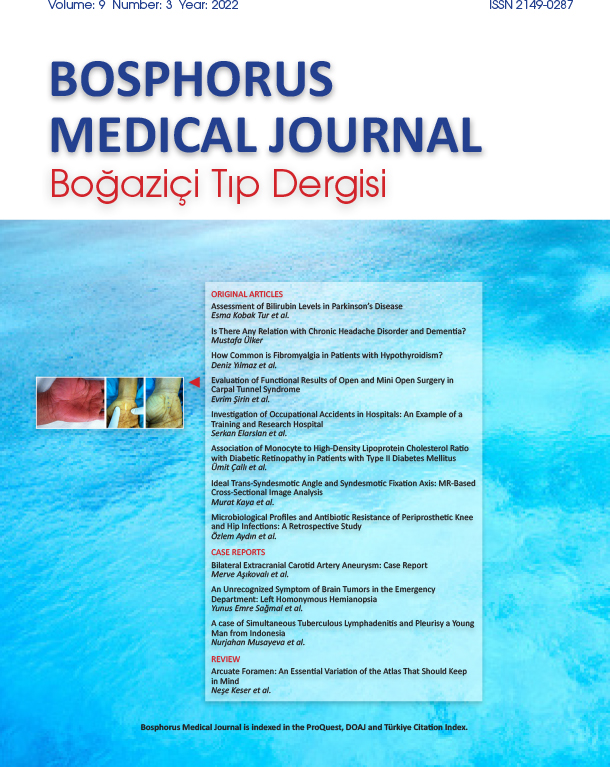Volume: 8 Issue: 3 - 2021
| 1. | Frontmatters Pages I - IX |
| ORIGINAL RESEARCH | |
| 2. | Investigation of the Relationship of IL-17 Gene Variants with Rheumatic Heart Disease Ayşegül Başak Akadam Teker, Erhan Teker doi: 10.14744/bmj.2021.02997 Pages 123 - 130 INTRODUCTION: Rheumatic heart disease (RHD) results from rheumatic fever (RA) caused by streptococcal throat infection. 3-6% of patients with rheumatic fever turn into RHD. Recent studies have shown that Th17 cells, a newly identified new effector T cell line, play a role in the pathogenesis of RHD. Host auto-reactivity mediated by cellular and humoral immune responses is known to play a role in RHD development, and interleukin (IL)-17 appears to be the leading actors in this process. Despite this central role in RHD pathogenesis, the number of studies on IL-17 variants is very limited. Moreover, there is no data related to this issue in Turkish society. Therefore, in this study, we aimed to investigate the relationship between IL-17A rs2275913 and IL-17F rs763780 polymorphisms in the pathogenesis of RHD. METHODS: In this case-control study, the study group consisting of 390 women (170RHD/220 control) IL-17A rs2275913, IL-17F rs763780 gene variants were examined using the TaqMan 5 'Allelic Discrimination Test method. RESULTS: The IL-17A rs2275913 genotype distributions among study groups were statistically significant (p=0.010). In addition, the IL-17A rs2275913 AA genotype was found in both single valve lesions (p=0.021) and combined valve lesions (p=0.038). It was statistically higher compared to the group. IL-17F rs763780 variants showed no association with RHD pathogenesis. DISCUSSION AND CONCLUSION: Based on our findings, we would like to report that the IL-17A rs2275913 variant is effective in both the pathogenesis and severity of RHD, and that we found a serious correlation in defining high sensitivity. We think that IL-17A rs2275913 variants can be recommended as a suitable biomarker for the identification of susceptible individuals in the Turkish population. |
| 3. | Evaluation of Clinical Results of Three Different Treatment Groups in the Patients with Moderate (Stage 2-3) Osteoarthritis Güzelali Özdemir, Barış Yılmaz, Kenan Bayrakçı, Erman Ceyhan, Uğur Günel doi: 10.14744/bmj.2021.98698 Pages 131 - 137 INTRODUCTION: The aim of this study is to analyze the effectiveness of intraarticular hyaluronic acid injection and arthroscopic debridement for stage 2 and 3 osteoarthritides of the knee based on the Kellgren-Lawrence system. METHODS: One hundred and thirteen patients with knee pain complaints diagnosed as osteoarthritis were divided randomly into three groups. The first group was treated with intraarticular hyaluronic acid injection the second group was treated with arthroscopic debridement operation and for the last group, both procedures were performed. The patients were evaluated with Lysholm Knee Score and Visual Analogue Scale just before and 3 months after the treatment. The evaluation has continued every 3 months for the rest of the year. RESULTS: About 82.3% (n=93) of the patients were female. There was no significant statistical difference between the groups according to age and Body Mass Index. All the three groups had significant improvement in the Visual Analog Scale (VAS) and Lysholm Scale compared with the starting values. This improvement especially occurred in the first 3 months, then stopped and entered a plateau phase between the 3 and 6 months. After the 6 month a decline phase starts although the values are still positive compared to starting ones. According to sex, the Lysholm scale values of male patients were statistically significantly higher at the 3, 6, 9, and 12 month. During the treatment period, no complications were observed among the patients. The existence of torn meniscus, plica, or injured or intact ACL did not influence the VAS and Lysholm values. The only significant score change was observed in patients with synovial hypertrophy. DISCUSSION AND CONCLUSION: We observed that arthroscopy alone or with additional hyaluronic acid injection after the operation is an effective treatment for knee osteoarthritis. For our selected patient group the first treatment option is intraarticular hyaluronic acid injection. If there is no significant improvement at the 3 and 6 months follow-up period an arthroscopic debridement procedure should be performed. If any cartilage injury is obtained during arthroscopic intervention we think that postoperative intraarticular hyaluronic acid improves functional scores. |
| 4. | Investigating the Consistency Between Pre-Operative Planning and Surgical Implementation for Degenerative Lumbar Spine Surgery Serdar Alfidan, Can Kosay, Barış Yılmaz, Ömer Akçalı doi: 10.14744/bmj.2021.33043 Pages 138 - 145 INTRODUCTION: We aim to establish and investigate the correlation between the pre-operative planning performed based on the pre-operative findings and the interventions performed during the surgery. METHODS: Sixteen patients with degenerative lumbar spine disorder who decided to be operated on by four orthopedics and traumatology specialists were included in the study. The inclusion criteria for patients were 2-fold: Development of spine disorder requiring surgery in the lumbar region on a degenerative basis and consideration of posterior spinal instrumentation at least in a level by the surgeons. Spine disorders developing secondary to congenital, traumatic, pathological, and infective etiologies were excluded from the study. Titanium alloy (Ti-6A1-4V) spinal instrumentation sets were used in the surgeries of all patients. To provide standard statistical analysis for the study, an assessment form consisting of 162 questions related to the patient complaints, clinical findings, results of radiographic examination, and the surgery planned was prepared. RESULTS: A strong kappa consistency was also found for interventions of discectomy, laminectomy, flavum excision, and posterior spinal instrumentation. An intermediate kappa consistency was found for foraminotomy and foraminectomy. It was found that findings of claudication and radiculopathy were completely inefficient in pre-operative planning; on the other hand, findings of the narrowing of the spinal canal interpreted with magnetic resonance imaging were highly efficient in pre-operative planning. Finally, it was determined that pre-operative planning performed for the level of L5-S1 of the lumbar spine region was much more inconsistent compared to the other levels of the lumbar spine region. DISCUSSION AND CONCLUSION: Findings of claudication and radiculopathy had no contribution to the planning, but the magnetic resonance imaging findings were valuable. Performing foraminotomy and foraminectomy at any surgical level or determining any surgical procedure that would be performed at the L5-S1 level with a pre-operative planning were found to potentially contain error. |
| 5. | Barrier Protective Effect of the Cream Consisting of a Mixture of Zinc and Silver in the Treatment of Diabetic Foot Wounds Hasan Murat Arslan, Perçin Karakol doi: 10.14744/bmj.2021.29291 Pages 146 - 153 INTRODUCTION: Diabetes mellitus is an endocrine disease that damages a wide variety of cell types with increased serum glucose. Diabetic foot ulcers, one of the complications of the disease, are the most well-known. These ulcers, which result in significant morbidity and mortality, affect 25% of patients with diabetes during the lifetime. Diabetic foot ulcers are a health problem due to their resistance to healing. Therefore, a new and good drug to be developed for this disease is of great importance. METHODS: In this study, a cream containing silver and zinc was applied to diabetic foot patients (n=25). RESULTS: The findings of this study revealed the antimicrobial properties of the application rich in silver and zinc in the diabetic foot. Significant effects on wound healing were demonstrated by follow-up at 1 week, 2 weeks, 1 month, 3 months, and 6 months. In this process, wound characteristics were evaluated based on features such as side tissue and wound depth. DISCUSSION AND CONCLUSION: Data stated that the cream is a therapeutic treatment tool that can be used in the clinic. |
| 6. | Neutrophil/Lymphocytes Ratio in Acute Ischemic Stroke Funda Alparslan, Eren Gözke doi: 10.14744/bmj.2021.36854 Pages 154 - 159 INTRODUCTION: Neutrophil and lymphocyte numbers are known to play a role in the inflammatory response and in the atherosclerotic process. The elevated level of neutrophil/lymphocyte ratio (NLR) is associated with prognosis, disease severity and mortality in cardiovascular diseases and atherosclerosis. In this study, we aimed to investigate whether NLR changed in acute ischemic stroke (AIS) patients, whether there was a relationship between NLR and lesion size, type of involvement, age, sex, and whether NLR had effect on short term prognosis. METHODS: One hundred and seventy-four patients admitted with AIS diagnosis were included in the study. Patients existing files were screened for anamnesis, physical and neurological examinations, chronic illness history, antiplatelet and anticoagulant use, complete blood count, cholesterol panel, routine biochemical examinations, cranial Computed Tomography and Magnetic Resonance Imaging findings. Patients were grouped according to Bamford classification and TOAST classification. RESULTS: Of the participants, 88 (50.9%) were female, 86 (49.1%) were male and the mean age was 73.8 ± 10.5 years. NLR was significantly higher in patients with AIS in terms of normal reference values. When patients were assessed within themselves, NLR increased as age increased. In the 50-59 and 60-69 age groups, NLR was higher in males. No gender difference was found over 70 years old patients. The NLR values of the total anterior circulation infarct group were significantly higher than the other groups (p=0.011; p=0.038; p=0.001). The NLR values of the patients with exitus were meaningfully higher than the surviving patients (p=0.006). DISCUSSION AND CONCLUSION: The NLR value is elevated in patients with AIS and correlates with increased age, male gender and wide infarct area. Higher NLR seems to predict short-term mortality and may be used as a prognostic tool. |
| 7. | Effect of Intravitreal Antivegf Injection on Intraocular Pressure in the Early Period Ayşe Sönmez, Murat Garlı, Sevda Aydın Kurna, Banu Açıkalın doi: 10.14744/bmj.2021.61687 Pages 160 - 164 INTRODUCTION: This study aims to evaluate the intraocular pressure (IOP) changes detected in the early period after intravitreal injection with bevacizumab, aflibercept and ranibizumab pre-filled syringe system. METHODS: 39 eyes of 39 patients with age-related macular degeneration (AMD), diabetic macular edema (DME) and retinal vein occlusion (RVO) who were treated with intravitreal antivegf agents were included in this study. IOP values were measured with Tono-pen (AVIA, Reichert, USA) just before injection, 1 minute, 30 minutes and 60 minutes after injection. RESULTS: The mean age of the patients was 66.08±10.18. 19 patients with AMD, 16 patients with DME and 4 patients with RVO were included in this study. 25.6% (n=10) of the cases were treated with intravitreal aflibercept, 35.9% (n=14) with bevacizumab and 38.5% (n=15) with ranibizumab pre-filled syringe system. The mean IOP value of the patients measured before injection was 17.36±3.99, 19.94±2.83 and 17.33±4.04 mmHg for aflibercept, bevacizumab, and ranibizumab, respectively. While the change in IOP values measured at 60 minutes after the injection compared to the pre-injection values was not significant, the increase in IOP measurements at 1 minute and 30 minutes after the injection was statistically significant. IOP values measured at 1st and 30th minute were not significant according to the antivegf agent types. DISCUSSION AND CONCLUSION: Antivegf agents administered intravitreally may cause sudden and temporary IOP elevation in the early period. Repeated applications, especially in glaucoma patients, may increase the glaucomatous damage of the patients. The amount of the intravitreal agent can be given in a more controlled way with disposable prefilled syringe systems. Although it is thought in practice that the sudden IOP elevation that occurs during an injection can be prevented by avoiding the use of excessive amounts, there was no significant difference in our study. |
| CASE REPORT | |
| 8. | A Hypoglycemia Case with Increased Seizures Due to Levetiracetam Use Ahmet Demir, Zeynep Aydın, Ayşe Destina Yalçın doi: 10.14744/bmj.2021.36025 Pages 165 - 167 Levetiracetam (LEV) is a new generation anti-seizure drug that acts by binding to the synaptic vesicle 2A protein found in the central nervous system and endocrine tissues, and can be preferred in focal and generalized epilepsies. It has side effects such as nausea, headache, dizziness, fatigue, somnolence, behavioral change, psychiatric disorder. Also, few studies have found that levetiracetam affects endocrine functions by increasing testosterone and estrogen secretion. Twenty-six-year-old male patient with a previous diagnosis of epilepsy was admitted to our clinic with fainting and convulsions. It was noteworthy that the patient, who was also diagnosed with reactive hypoglycemia, increased fainting due to hypoglycemia under levetiracetam treatment. Therefore, the patient's levetiracetam treatment was discontinued and 2000 mg/day valproic acid was started. It was observed that fainting due to hypoglycemia did not recur and also did not have generalized convulsions. Hypoglycemia is one of the rare side effects that can be seen due to LEV use. In our case, it was observed that LEV caused an increase in the patient's existing hypoglycemia and especially triggered the patient's seizures. In cases where the patient's seizures or complaints increase following LEV use, it should be kept in mind that hypoglycemia may be triggered and an increase in epileptic seizures may occur due to the use of LEV. |
| 9. | A Potentially Fatal Tissue Defect That Reveals the Cardiac Implantable Electronic Device Perçin Karakol, Tevfik Balıkçı, Mehmet Bozkurt doi: 10.14744/bmj.2021.93898 Pages 168 - 172 In the treatment of end-stage heart failure, cardiac device implantation applications continue at an extremely rapid pace. As the applications increased, the complication rates also increased. These include its large size for pediatric patients and its impact on surrounding tissues due to compression, as well as systemic complications such as infection and bleeding. This case is an 11-year-old male with a left thoracolateral tissue defect and device opening after left ventricular assist device implantation. In the treatment, a partial latissimus dorsi myocutaneous flap was performed and no postoperative complications were experienced. As the donors suitable for heart transplantation are generally adults all over the world, the patient has gained time for the transplant. We believe that this flap is easy and safe for this type of tissue defects. As device replacement can also be a mortal condition, the defect was immediately covered with a suitable tissue of sufficient thickness and vascularity. |
| 10. | A Rare Case of Vasculopathy: Susac Syndrome Didem Girgin, Murat Çabalar, Hacı Ali Erdoğan, Ismail Umut Onur, Kamil Hakan Kaya, Ebru Temiz, Vildan Yayla doi: 10.14744/bmj.2021.26056 Pages 173 - 176 Susac syndrome (SS) is a rare disease characterized by encephalopathy, retinopathy and hearing loss. It should be considered in diagnosis and should be taken into consideration in the differential diagnosis of vasculopathy. An early diagnosis which can stop the progression of the disease and prevent permanent disability is important. Herein, we reported a case of Susac syndrome in a 32-year-old man. We emphasized the importance of early diagnosis, the criteria for diagnosis, and the importance of an aggressive therapeutic approach, including a combination of steroids and other cytotoxic drugs. |
| 11. | Purple Bag Urinary Syndrome: A Rare Clinical Condition Jülide Sayın Kart, Banu Çevik, Elif Bombacı, Kemal Tolga Saraçoğlu doi: 10.14744/bmj.2021.18894 Pages 177 - 179 Purple urine bag syndrome (PUBS) is a rare clinical condition characterized by the interaction of indigo (blue) and indirubin (red) pigments with polyvinyl chloride (PVC) containing material, which is released by tryptophan metabolism due to bacterial colonization in the urinary catheter. This syndrome is not well recognized by clinicians, so the management of these patients is a challenge. We aimed to represent a critically ill patient developing PUBS and review the existing literature. |
| 12. | A Rare Side Effect: Statin Induced Autoimmune Necrotizing Myopathy Tuba Nazlıgül, Ilknur Aktaş, Feyza Ünlü Özkan, Pınar Akpınar, Eren Gözke doi: 10.14744/bmj.2021.25743 Pages 180 - 182 Statin induced necrotizing autoimmune myopathy is a rare side effect and requires immunosuppressive therapy. Persistence of proximal muscle weakness and elevated creatine kinase level despite statin discontinuation, muscle necrosis and elevated anti-HMGCR (3-hydroxy 3-methyl glutaryl coenzyme A reductase) autoantibodies are distinguishing features from other statin related musculoskeletal side effects. In this report, a case using statin and diagnosed with autoimmune necrotizing myopathy is presented. |
| REVIEW | |
| 13. | Complementary Therapies in Cerebral Palsy Pınar Akpınar doi: 10.14744/bmj.2021.32448 Pages 183 - 187 Physical therapy and rehabilitation practices in Cerebral Palsy (CP) aim to minimize the effects of physical disability on the development of the child and increase the quality of life of the child and family, and reintegrating the child into society as an independent and social individual. As in every field to protect health, creative and supportive approaches are required in SP. Complementary medicine applications are used mostly in chronic diseases in the world and in our country. However, limited high quality scientific evidence makes it impossible to apply many complementary medicine methods and increases the necessity of further research. In this article, the latest literature has been reviewed and complementary therapies applied in CP are summarized with scientific evidence. |




















